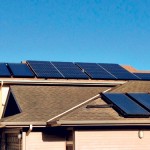The Time is Right to Invest in a Solar System for Your Home
Now that the fourth quarter of the year has started, activity in the solar energy market is literally “heating up.” Potential governmental action with far-reaching effects for consumers is also on the horizon.
It is widely believed that the State Legislature is contemplating revisions to the tax code, which could restrict and/or reduce energy tax credits in an effort to combat the state’s budget shortfall regarding tax revenues. A reduction from 35 percent to 25 percent is rumored to be in the works. Some believe that any such action in the 2013 session will take effect in 2014.
A recent article indicated the state Department of Taxation plans to unilaterally implement changes to the tax credits that homeowners can claim in a given tax year. While legislative action is necessary to reduce the percentage or amount of the allowable credits, the department believes it has the power to limit the number of PV systems that may be claimed per qualified residence per tax year. So much for the idea that there is time left for consumers to take advantage of the nation’s most generous renewable energy tax credit program.
Even without tax incentives, photovoltaic (PV) electrical systems are still attractive from a financial perspective. A $30,000 system that saves $200 per month equals an 8 percent annual rate of return. Less competitively priced designs still return at least 5 percent annually — have you checked the rates on money-market funds lately? The more efficient and aggressively priced systems check in at nearly 10 percent. With the current incentives, returns are in the range of 20-25 percent or more.
Some cynics have advanced the idea that solar companies may attempt to drum up more business by using the anticipated state action as a “scare tactic.” This did occur to a small degree in 2011 when a number of contractors used the “15 percent saturation” argument to rush consumers without informing them of the state Public Utilities Commission’s action in raising that rule to 50 percent.
Consumers who undertake action as quickly as possible benefit by saving on their utility costs sooner than later. After all, every dollar paid to the power company is money that will never be recovered.
Let’s not deceive ourselves, though. Hasty action has the effect of not doing one’s “due diligence” in making the wisest choice among all the contractors available. In the end, the “wrong” choice could cost the consumer thousands.
Is it time for consumers to “pull the trigger” and “go green?” If the homeowner is financially able, “beating the clock” for the higher tax credits makes a lot of sense.
The answer is an emphatic yes, but there is one caveat: Based on increased advertising on television, radio and print media, it seems that many solar companies are new players that were not in the business a year ago. It is likely that a good number of them are merely marketing organizations that sub-contract their installations. The full-service contractors seem to be a dwindling breed.
Hi-Power Solar is one such “full-service” contractor. Principals Ron Romero, who has more than 20 years in the solar business, and Matt Adams, who has more than 16 years, offer an excellent balance of top-notch components, expert installation and competitive pricing. They are familiar with the city and county building codes as well as special homeowner association rules.
It pays to be a little cautious in choosing the most appropriate system and exploring financials that impact your pocketbook.
contact // 342-0802
web // www.hi-powersolar.com
